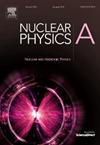裂变异构体研究与先进的实验设施和检测系统
IF 2.5
4区 物理与天体物理
Q2 PHYSICS, NUCLEAR
引用次数: 0
摘要
在锕系区(Z = 92 - 97, N = 141- 151)发现的裂变异构体“岛”来自多峰裂变垒。裂变异构体是超变形的,具有低自旋,代表了核景观的极端之一。然而,从20多年前的实验中只获得了很少的实验信息。实验设备和检测系统的进步使我们能够恢复裂变异构体研究的实验活动。例如,在Jyväskylä的IGISOL设施中产生了240,242Am的裂变异构体并测量了它们的延迟裂变。在达姆施塔特的GSI,正在探索在U-Np区产生238U碎片的裂变异构体。本文回顾了235,236U和240,242Am的裂变异构体,这些异构体正在重新访问。本文章由计算机程序翻译,如有差异,请以英文原文为准。
Fission isomer studies with advanced experimental facilities and detection systems
The ‘island’ of fission isomers identified in the actinide region (Z = 92 - 97, N = 141- 151) originates from multi-humped fission barriers. Fission isomers are superdeformed and with a low spin representing one of the extremes of the nuclear landscape. However, only scarce experimental information was gained from experiments performed more than 20 years ago. The advances in experimental facilities and detection systems allow us to revive the experimental activities on fission isomer studies. For example, producing fission isomers in 240,242Am and measuring their delayed fission have been achieved at the IGISOL facility in Jyväskylä. Exploring the production of fission isomers in the U-Np region with 238U fragmentation is ongoing at GSI, Darmstadt. This paper reviews fission isomers in 235,236U and 240,242Am, which are being re-visited.
求助全文
通过发布文献求助,成功后即可免费获取论文全文。
去求助
来源期刊

Nuclear Physics A
物理-物理:核物理
CiteScore
3.60
自引率
7.10%
发文量
113
审稿时长
61 days
期刊介绍:
Nuclear Physics A focuses on the domain of nuclear and hadronic physics and includes the following subsections: Nuclear Structure and Dynamics; Intermediate and High Energy Heavy Ion Physics; Hadronic Physics; Electromagnetic and Weak Interactions; Nuclear Astrophysics. The emphasis is on original research papers. A number of carefully selected and reviewed conference proceedings are published as an integral part of the journal.
 求助内容:
求助内容: 应助结果提醒方式:
应助结果提醒方式:


